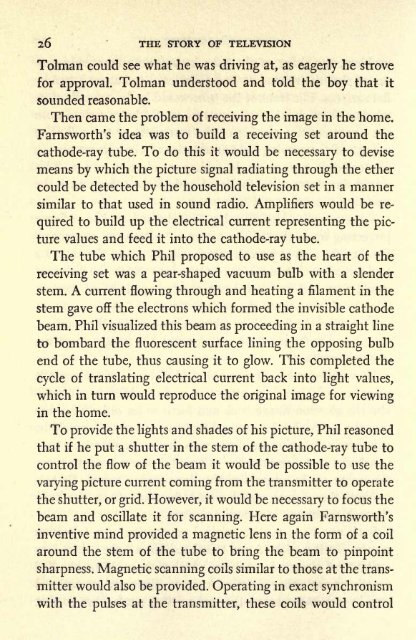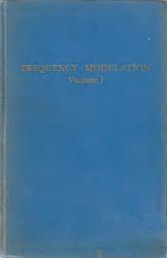the life of Philo T Farnsworth - Early Television Foundation
the life of Philo T Farnsworth - Early Television Foundation
the life of Philo T Farnsworth - Early Television Foundation
Create successful ePaper yourself
Turn your PDF publications into a flip-book with our unique Google optimized e-Paper software.
26 THE STORY OF TELEVISION<br />
Tolman could see what he was driving at, as eagerly he strove<br />
for approval.<br />
Tolman understood and told <strong>the</strong> boy that it<br />
sounded reasonable.<br />
Then came <strong>the</strong> problem <strong>of</strong> receiving <strong>the</strong> image in <strong>the</strong> home.<br />
<strong>Farnsworth</strong>'s idea was to build a receiving set around <strong>the</strong><br />
cathode-ray tube. To do this it would be necessary to devise<br />
means by which <strong>the</strong> picture signal radiating through <strong>the</strong> e<strong>the</strong>r<br />
could be detected by <strong>the</strong> household television set in a manner<br />
similar to that used in sound radio.<br />
Amplifiers would be required<br />
to build up <strong>the</strong> electrical current representing <strong>the</strong> picture<br />
values and feed it into <strong>the</strong> cathode-ray tube.<br />
The tube which Phil proposed to use as <strong>the</strong> heart <strong>of</strong> <strong>the</strong><br />
receiving set was a pear-shaped vacuum bulb with a slender<br />
stem. A current flowing through and heating a filament in <strong>the</strong><br />
stem gave <strong>of</strong>f <strong>the</strong> electrons which formed <strong>the</strong> invisible cathode<br />
beam. Phil visualized this beam as proceeding in a straight line<br />
to bombard <strong>the</strong> fluorescent surface lining <strong>the</strong> opposing bulb<br />
end <strong>of</strong> <strong>the</strong> tube, thus causing<br />
it<br />
to glow. This completed <strong>the</strong><br />
cycle <strong>of</strong> translating electrical current back into light values,<br />
which in turn would reproduce <strong>the</strong> original image for viewing<br />
in <strong>the</strong> home.<br />
To provide <strong>the</strong> lights<br />
and shades <strong>of</strong> his picture,<br />
Phil reasoned<br />
that if he put a shutter in <strong>the</strong> stem <strong>of</strong> <strong>the</strong> cathode-ray tube to<br />
control <strong>the</strong> flow <strong>of</strong> <strong>the</strong> beam it<br />
would be possible to use <strong>the</strong><br />
varying picture current coming from <strong>the</strong> transmitter to operate<br />
<strong>the</strong> shutter, or grid. However, it would be necessary to focus <strong>the</strong><br />
beam and oscillate it for scanning. Here again <strong>Farnsworth</strong>'s<br />
inventive mind provided a magnetic lens in <strong>the</strong> form <strong>of</strong> a coil<br />
around <strong>the</strong> stem <strong>of</strong> <strong>the</strong> tube to bring <strong>the</strong> beam to<br />
pinpoint<br />
sharpness. Magnetic scanning coils similar to those at <strong>the</strong> transmitter<br />
would also be provided. Operating in exact synchronism<br />
with <strong>the</strong> pulses at <strong>the</strong> transmitter, <strong>the</strong>se coils would control











